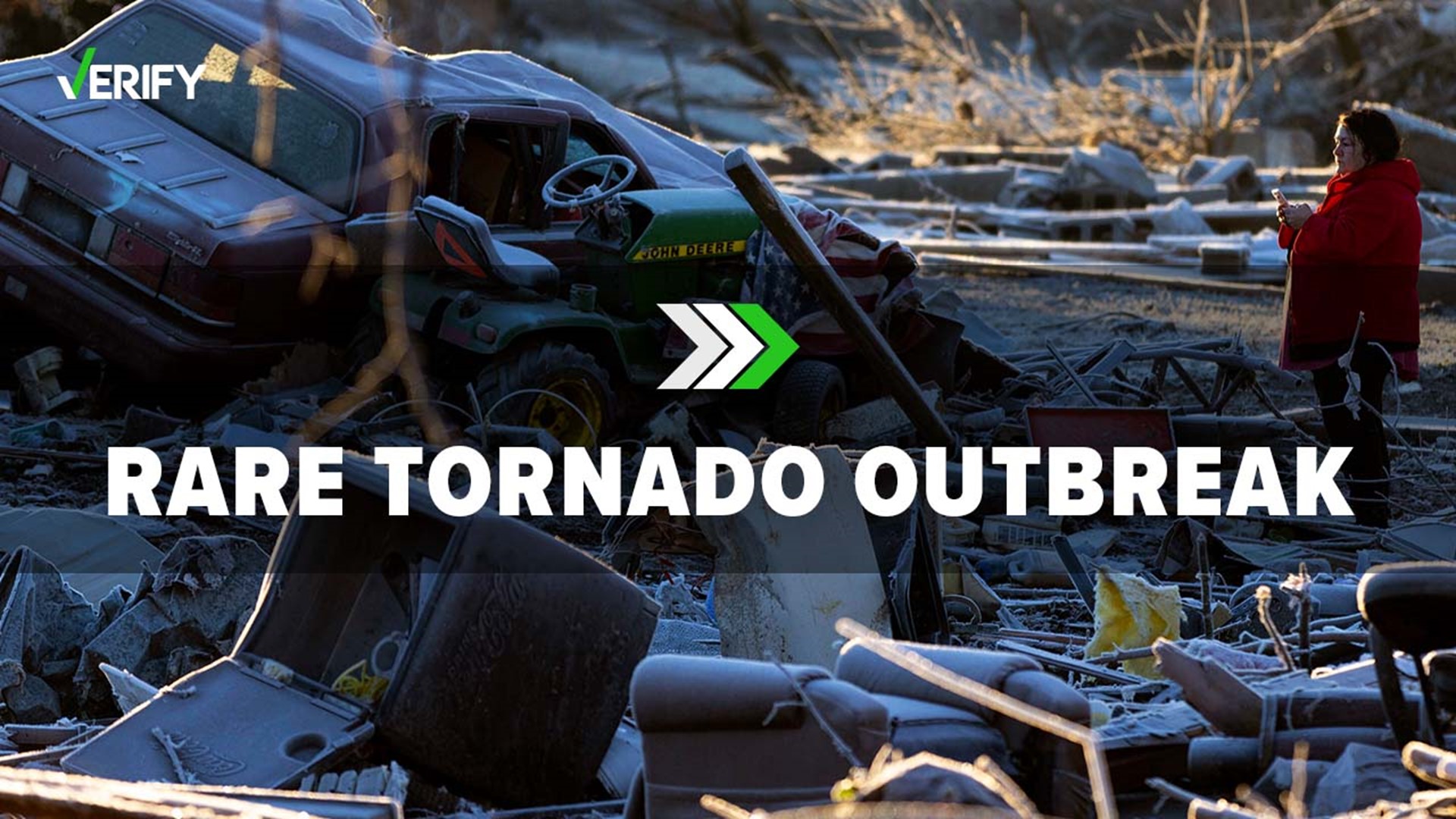Immediately after the Dec. 10 and Dec. 11 tornado outbreak that hit Arkansas, Kentucky, Missouri, Tennessee and Illinois, the National Weather Service’s storm reports made it clear that the tornadoes were strong enough to cause “catastrophic” damage and dozens of deaths.
Houston-based meteorologist Matt Lanza said these kinds of tornadoes are “rare” in December, and CBS meteorologist Jeff Berardelli called it a “rare historic December tornado outbreak.” Many other commenters online wondered just how unusual a tornado outbreak in December is, given “tornado season” is typically around May.
THE QUESTION
Is it rare for there to be a severe tornado outbreak in December?
THE SOURCES
Taylor Kanost, a meteorologist at WOI in Des Moines, Iowa
Daryl Herzmann, project coordinator of Iowa Environmental Mesonet of Iowa State University
THE ANSWER
Yes, it is rare for there to be a severe tornado outbreak in December. While tornadoes do occasionally occur during the month, they don’t occur frequently and rarely produce catastrophic tornadoes.
WHAT WE FOUND
Tornadoes do develop in December, but far less frequently than they do in warmer months. Charts from the Storm Prediction Center (SPC) show that between 1950 and 2010, tornadoes developed less frequently in December and January compared to the rest of the year. According to the SPC, there are zero tornadoes in an average December in the states of Kentucky and Tennessee, which were both hit hard by the most recent tornado outbreak.
“The U.S. averages about 24 tornadoes in the month of December every year, so it happens in December,” said Taylor Kanost, a meteorologist at WOI in Des Moines, Iowa. “These major outbreaks are not very common in the month of December and outbreaks with these violent tornadoes are quite uncommon. In fact, in recorded history, since 1950, there have only been two EF5 tornadoes in the month of December in the entire United States. Both of those occurred in the 1950s.”
The National Weather Service (NWS) says an EF5 tornado is the strongest tornado by observed damage that there can be, measured on a scale of EF0 to EF5, with EF0 being weak, EF3 being severe and EF5 being catastrophic. EF5 tornadoes are incredibly rare, so rare that Kanost says the last EF5 in the United States was an Oklahoma tornado in 2013. The NWS says the tornado that hit Mayfield, Kentucky in the latest outbreak was at least an EF3 — and Kanost says there’s a chance its rating could be increased to an EF4 or EF5 after damage surveys are complete.
“EF5 tornadoes in the first place are very rare,” Kanost said. “In December, it's very, very uncommon, almost unprecedented.”
The reason it’s so rare is because tornadoes, especially tornadoes in violent outbreaks, need air that you’d typically find in the spring.
“For tornadoes, you need a lot of moisture in the air — warm, moist air that helps create these thunderstorms that then produce tornadoes,” Kanost said. “There's not a lot of warm, moist air available in the month of December, typically.”
The National Severe Storms Laboratory says the cooler months sometimes have that warm, moist air necessary for tornadoes — but that’s typically in the south. This “secondary” tornado season in November and occasionally December occurs in Mississippi and Alabama, according to the National Weather Service.
There is only one other archived instance since 2013 of the National Weather Service issuing a December tornado warning so far north: a Dec. 1, 2018 tornado outbreak in central Illinois. According to Daryl Herzmann, who archives NWS warnings and reports, there were more tornado warnings issued on Dec. 10, 2021, than there has been on any December day since he’s had reliable archives dating back to 2001.
“So it's even a little bit more bizarre that we had that air mass farther north up in Kentucky.”

